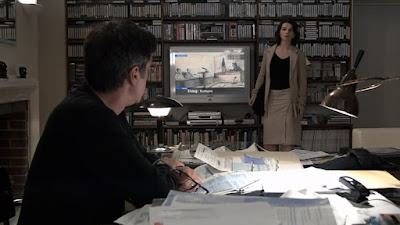 Caché (Michael Haneke, 2005) Pronounce it with the accent, please, because it doesn't refer to a hiding place. The french is an attribute, as in "hidden," "secret," or "covert." "Caché" is all of that, and more taking a small situation and blowing it up in the background until it becomes an indictment of a secret sin, not only of an individual but an entire country.
Caché (Michael Haneke, 2005) Pronounce it with the accent, please, because it doesn't refer to a hiding place. The french is an attribute, as in "hidden," "secret," or "covert." "Caché" is all of that, and more taking a small situation and blowing it up in the background until it becomes an indictment of a secret sin, not only of an individual but an entire country.
I forget which of the early astronauts said it, but when asked to describe space-flight he drawled: "It's hours of boredom punctuated by moments of blind terror." He could have been talking about life, as well. And so, too, is "Caché," sly enough to take what might be boring for a viewer and turning it into a subtle trick, like the dinner guest depicted in the film who tells a long and involved story only to have it explode in the punch-line. That risk of boredom is the key, for Haneke employs long unbroken takes, sometimes not even moving the camera, but employing a stock-image—a staging area—through which the world and his characters move. The longer it takes, the more anticipation is built up in an audience; one begins to question why one is looking at something for so long, and then to look for the importance of that image and one's senses go on alert: what is that in the corner of the frame?; is it a still image, or is something moving?; one hears the doppler of a car-engine and anticipates its entering the frame. Why are we here, and why are we looking at this, are the questions.*
The answer is a joke and also a key to the suspense of the story. A well-to-do nuclear family—he (Daniel Auteuil) is a televised literary critic and she (Juliette Binoche) is a book publisher, their son, a diffident middle-schooler—begin receiving mysterious video cassettes wrapped in violent child's drawings. Viewing the cassettes, the couple realize they're being targeted and monitored, but they don't have a clue as to why or by whom. The answer must be some secret one or the other is hiding, and soon the couple are quibbling and quarrelling...and keeping their own secrets from each other.
Haneke is an austere film-maker with a trickster's heart—his most controversial film is the sadistic Funny Games which he made in both European (1997) and U.S. (2007) versions—and here, it's basically the same gambit but without the smirking meta-smugness. Here, its about story-telling (and audience puppeteering), his camera moves are controlled, liking riding on a secret rail, formal and distancing, not so much mindful of Hitchcock, as Brian De Palma's magically smooth and impersonal camera-glides, just an extension of those monitoring tapes, coolly surveying.
But the film is punctuated by the rare burst of upsetting violence that occurs quickly (so quickly it takes a moment to register..."Did they just...?") and is usually the end-point of a strategy (real or imagined) by the players. One is left contemplating responsibility as the characters in the play do, with no end (or conclusion) in sight. It's frustrating, but not false, and gives the film the grit of reality...while also keeping an audience on the edge of their chairs waiting for the next shock.

Mon Dieu, où est Waldo?
* One of my favorite shots in Bryan Singer's film-career (there aren't many) occurs in The Usual Suspects, when at one point in the movie there is a short sequence where, once the movie is over, we realize "that was a shot of nothing." No importance, whatsoever, except as a red herring thrown to the audience to play on their suspicions and ability to anticipate plot-points.



No comments:
Post a Comment